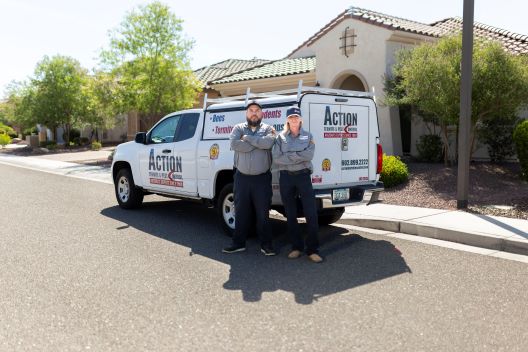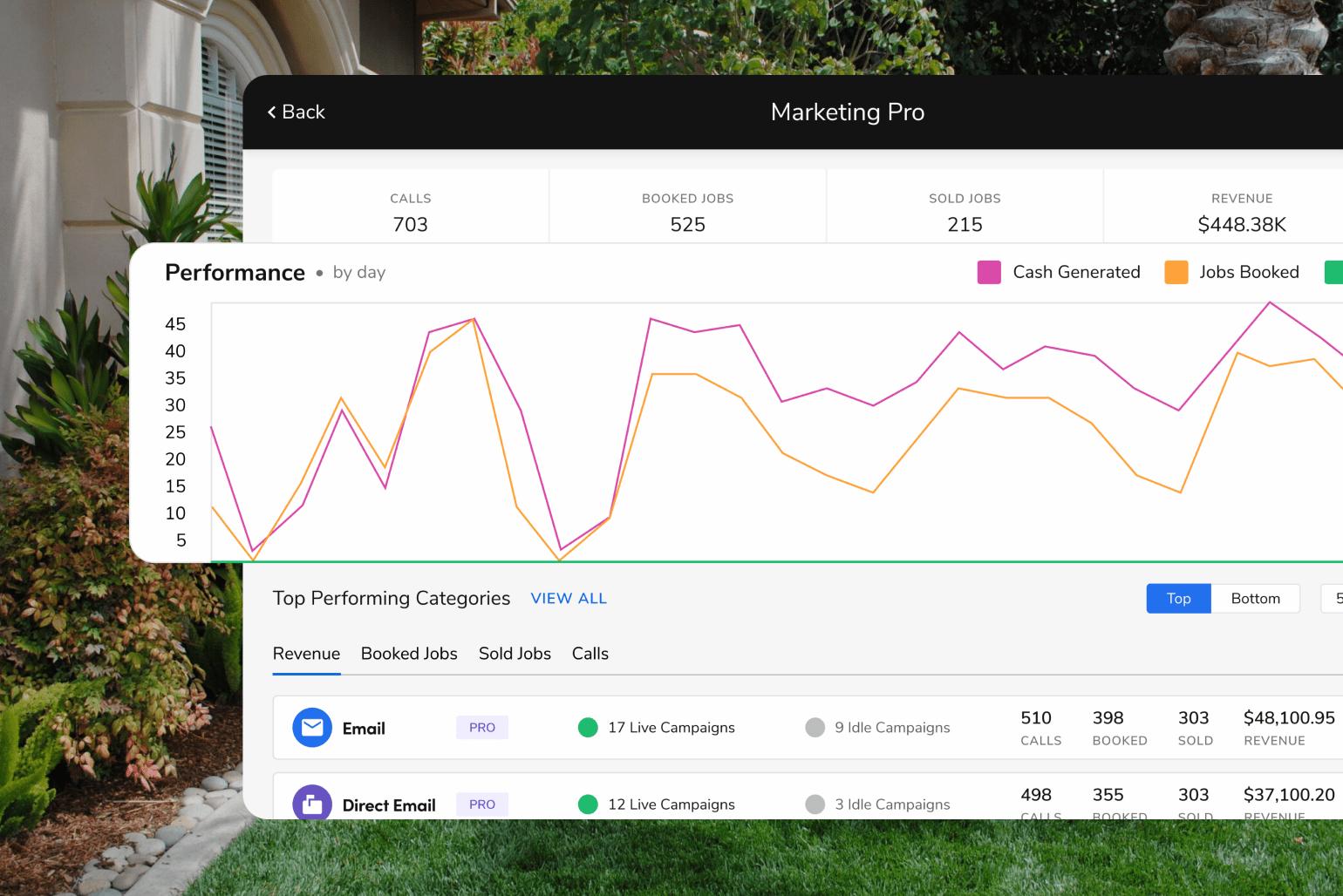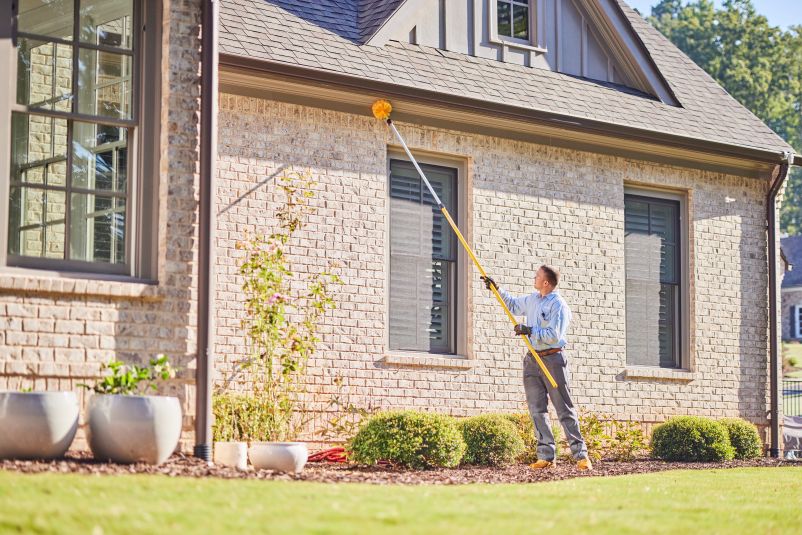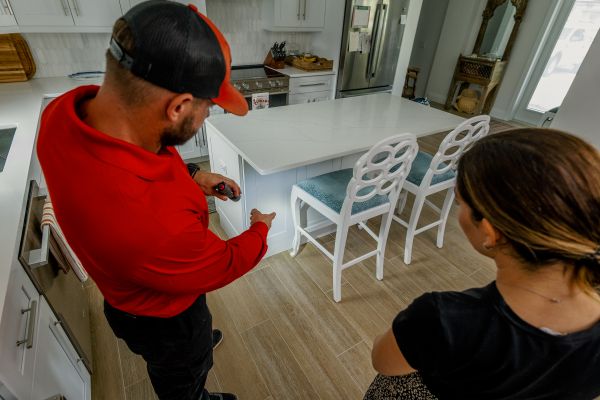SEO for Lawn Care Businesses: Attract More Clients Online
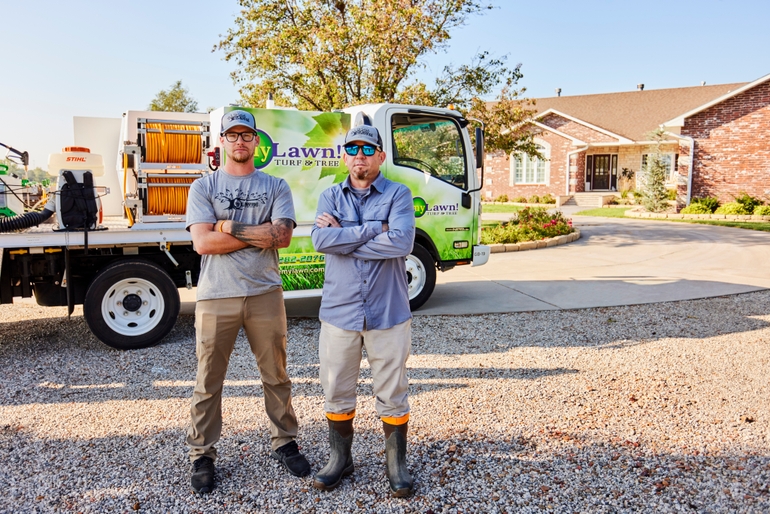
When potential customers need lawn care or landscaping services, they look online. That’s where more than 90% of shopping journeys begin today. To be discovered by these online shoppers, your business must be optimized for online search.
SEO, or search engine optimization, is the process of improving your website so it ranks higher in customers’ online searches. The core of SEO success occurs from targeting relevant keywords with high-quality content. The more you do that, the more qualified leads you’ll attract.
Of course, there are plenty of other SEO strategies for improving your SEO. Luckily, you don’t need to guess which ones will have the most impact. Follow these six SEO tips and tactics specifically tailored for lawn care companies, and you’ll build a website that steadily attracts organic leads.
1. Target Local Keywords
Targeting local keywords means strategically using location-specific keywords throughout your website and marketing content. Doing so pushes your business higher in online search results — specifically, searches by people likely to be in your service area.
“Houston lawn mowing service” and “organic lawn care” are examples of local keywords, though in different contexts. The first instance names a city. The second helps you compete when customers search for variants such as “organic lawn care near me.”
You need high-quality content paired with relevant keywords to convert those visitors into leads. In SEO terms, relevance refers to how well search engines see your content relating to a keyword. Location is one of the most basic forms of relevance. It wouldn’t help to show Phoenix lawn care businesses to someone who lives in Minneapolis.
Tip: Start with a keyword research tool that’s either free or offers a trial, such as Google Keyword Planner or Ahrefs. Enter potential search terms like “weed control,” paying attention to factors like search volume and competition.
Structuring Local Keywords Throughout Your Website
Good Nature Organic Lawn Care offers a strong example of how to incorporate local keywords throughout your website. The homepage competes for Good Nature’s overarching service category by targeting the keyword “organic lawn care.”
From there, the website breaks down Good Nature’s offerings with individual service pages, each targeting distinct keywords.
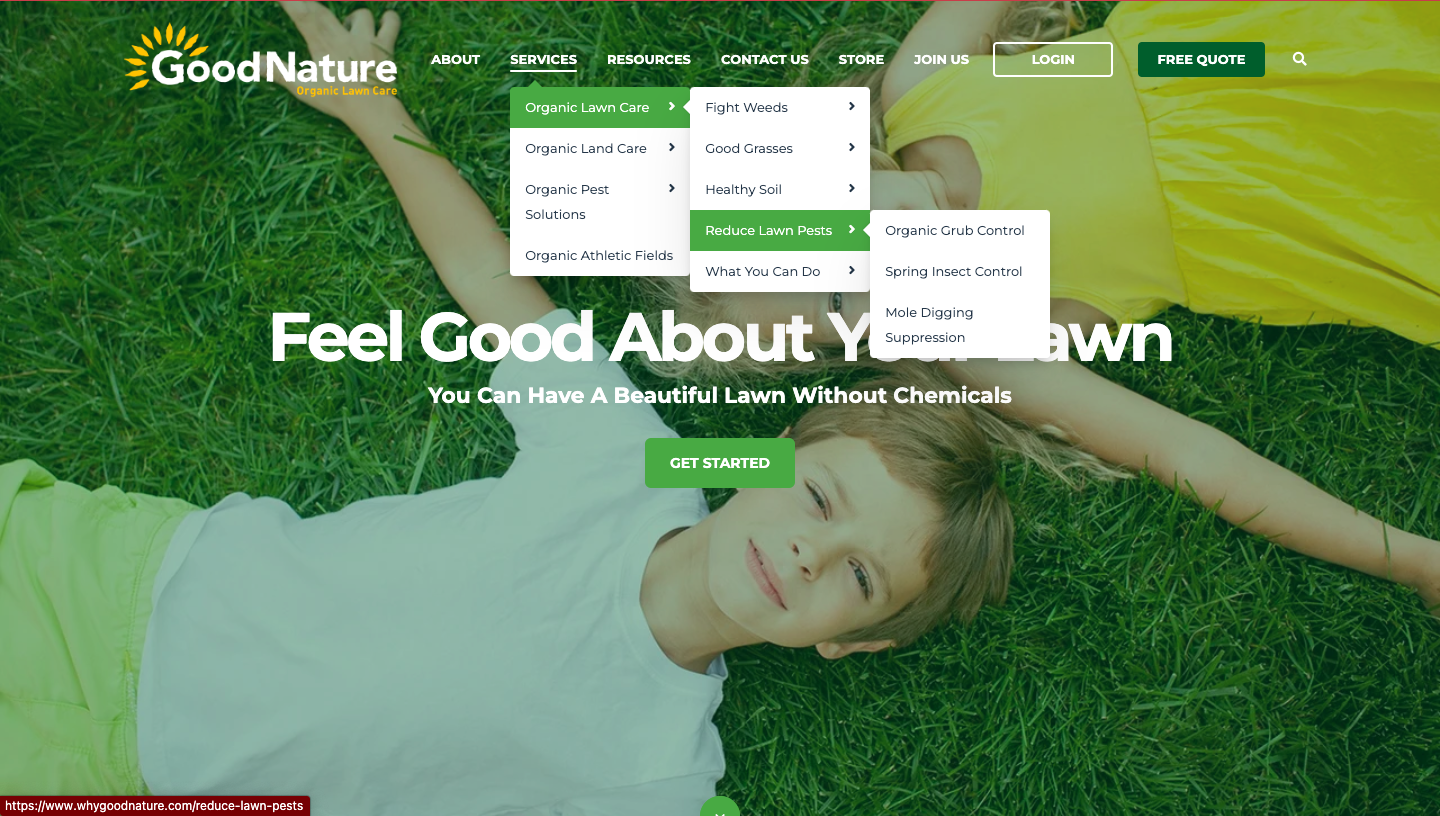
Image Source: Good Nature Organic Lawn Care
This SEO website design works well because it positions your top web pages to appeal to local customers. As for targeting keywords not bound by location, Good Nature could use its blog. For example, an article recommending the “best organic lawn fertilizers” might appeal to more customers.
You can streamline all of this, too, with solutions like FieldRoutes, a ServiceTitan Company. The FieldRoutes® Marketing Suite packages web design, SEO services, and more marketing tools into one software platform built for lawn care businesses.
Tip: When creating content to target keywords, focus on helping the reader first, and optimizing for search second. If you focus on helping over optimizing, you’ll probably optimize your content automatically, which then makes your brand come across as more authentic and trustworthy.
2. Create a Google Business Profile (Formerly Google My Business)
Creating a robust Google Business Profile (formerly known as Google My Business, or GMB) is one of the best ways to improve your lawn care SEO. That’s because your Google Business Profile is a major ranking factor for search engines: Google Search and Google Maps.
Notice on the screenshot below for “lawn care Cincinnati” how only two of three results from Google Search (left) also appear on Google Maps (right). Lawn Love is likely missing clicks because searchers can’t readily see its location.
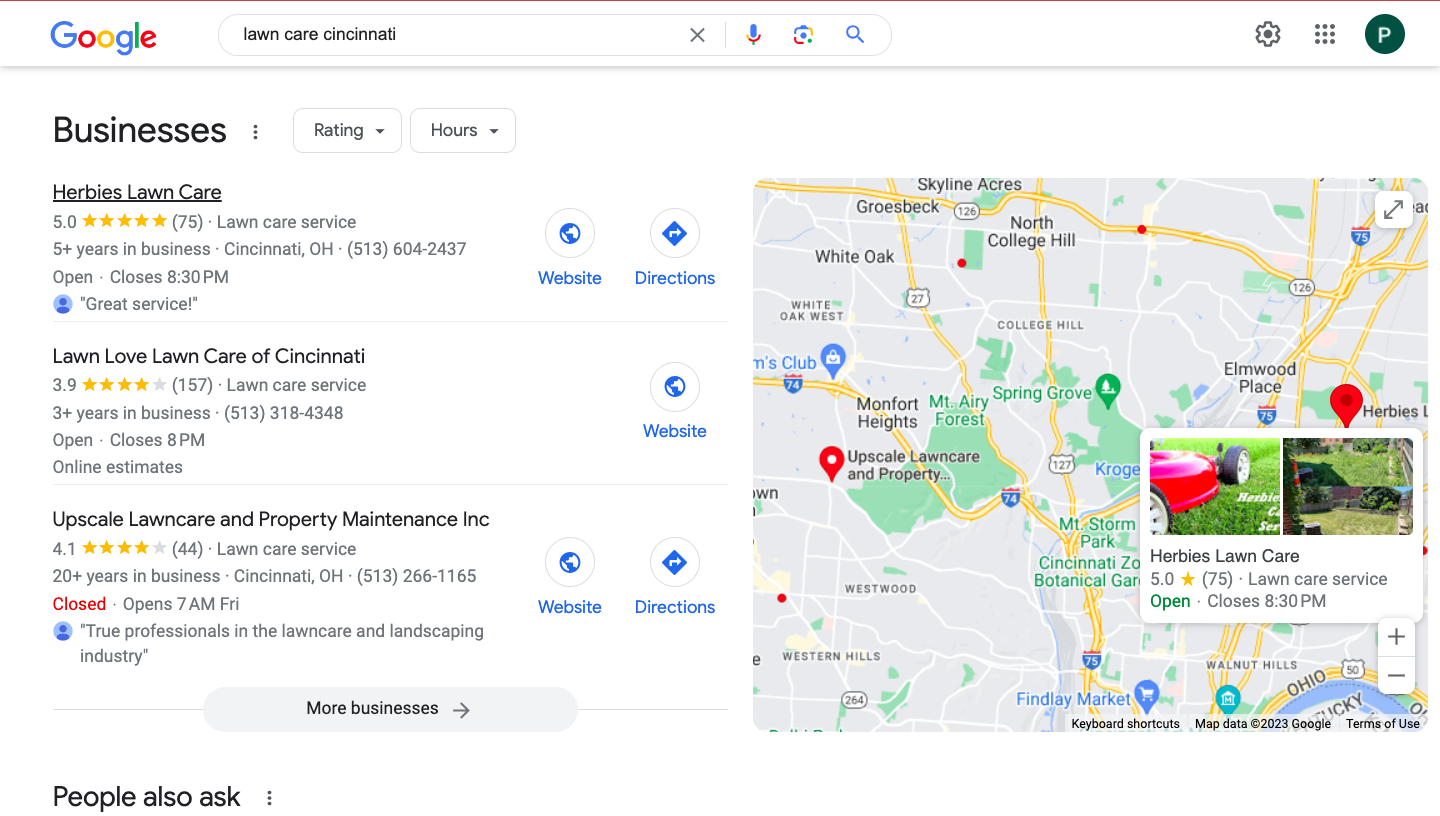
Image Source: Google
The more optimized your Google Business Profile is — and the more you engage with customers there — the higher it will rank in local search. A good place to start is Google’s advice for completing your business profile. Other optimizations include:
Posting content such as photos from the field
Listing lawn services and promotions
Tip: Claim and build out free profiles on other business listings such as Yelp, Better Business Bureau (BBB), and Yellow Pages. Cut and paste from your Google Business Profile to speed things up. Get your off-site SEO even faster by getting help from FieldRoutes.
Each listing counts as a citation, one of the most important ranking factors in local search. The more citations corroborating your name, address, and phone number (NAP) — and other details like hours of operation — the more reputable your business looks to search engines.
3. Optimize Title Tags and Meta Descriptions
Your web pages' title tags and meta descriptions have a strong impact on your click-through rates from search engine results pages (SERPs). Therefore, optimizing these fields should be standard practice in your lawn care SEO.
The screenshot below shows two results from the SERP for “Orlando lawn care.” The title tags are boxed in red, and the meta descriptions are in blue.
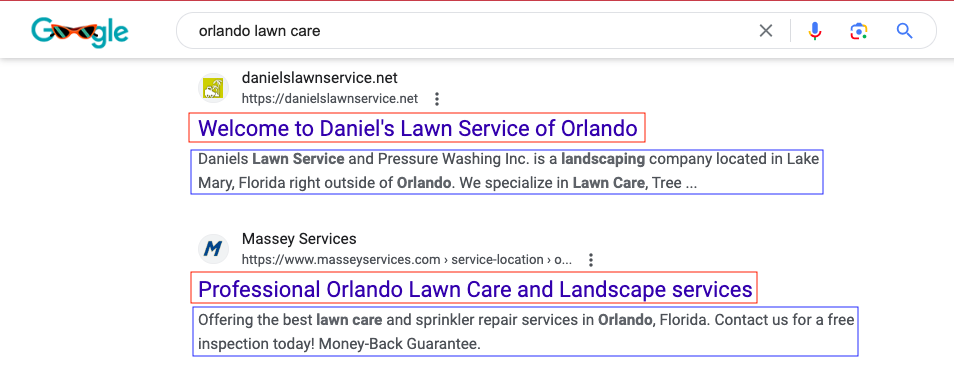
Image Source: Google
The title tag specifies the title of a web page, which displays as a clickable headline on SERPs. The meta description summarizes the web page, giving searchers a sense of how well the page matches what they’re looking for.
Therefore, the ability to write brief but engaging title tags and meta descriptions will help you stand out in local SEO.
Best Practices for Optimizing Title Tags and Meta Descriptions
Keep them concise. Target 50–60 characters for title tags and 150–160 characters for meta descriptions. These character limits ensure a polished, professional look on SERPs.
Make them compelling. Look at the meta descriptions of top-ranking results and ask how you can stand apart. Specifically, how can you describe your web pages so they’re even more compelling to potential lawn care customers?
Use target keywords. If you write a landing page targeting the keyword “landscaping business,” include “landscaping business” in the title tag and meta description, too.
4. Publish Local Content
Regularly publishing content is one of the smartest investments you can make. It supports lead generation over the short term by keeping your audience engaged. Over the long term, it builds your audience and brand as you compile a library of SEO-optimized blogs and web pages, all steadily earning you backlinks.
The best content comes from thoughtful keyword research that considers the intent behind each keyword. What do local customers want to know about “weed control” versus someone searching five states away? Asking questions like that will lead you to content ideas like:
Blogs targeting long-tail keywords, such as “pre-emergent weed control,” tailored to your geography and linked back to your page targeting “weed control”
A video targeting “cardboard for weed control” where you demonstrate how to kill weeds with cardboard
A blog or landing page targeting “lawn weed control” with a downloadable guide on local grassy weeds
Tip: Make content a team sport. Content takes time to produce, so get your team and customers involved to finish projects faster. Delegating the steps of on-site SEO is an excellent place to start. Outside help is available, too. FieldRoutes accelerates your creative output by offering content creation services alongside our lawn care software.
5. Encourage Customer Reviews
Reviews help customers make decisions. Positive reviews are a form of social proof that make new customers more inclined to book your services. Positive reviews also boost your local SEO, since search engines want to recommend the best local businesses.
But good reviews don’t happen automatically; they require some nudging. All you need are a few easy steps to turn into a repeatable process:
Create review request templates. Start with a message that works for any customer but still reminds them who you are and what you did for them. For instance, “Thanks for choosing Yellow Brick Road Lawn Care! We’d love your feedback on your experience.” Add a link to the review and ship it via email, text, or social media.
Offer incentives … or, on second thought, don’t. You’ve probably gotten a review request that offered some kind of incentive, like a drawing for a gift card. So, incentives do happen. However, Google policy forbids incentivizing reviews. Your best bet is running tests to determine what time, message, and medium most consistently convert into reviews.
Send follow-up messages. People get busy, so sometimes, a friendly nudge puts something back on their radar that they mean to do. Acknowledge the follow-up so it connects to your previous message, and reiterate how great it’d be to hear their feedback.
Respond to reviews promptly, too. According to Google, replying to reviews is an indicator of customer trust. Businesses that regularly engage with customers online are seen as more responsive and trustworthy than those that don’t.
Tip: Encourage and engage with customer reviews from all your online directory listings, not just your Google Business Profile. Directories such as Yelp and social media platforms like Facebook are high-quality sites in Google’s eyes. Strong business profiles on other sites create stronger ranking signals overall.
6. Improve Website Speed
Search engines use website speed to measure user experience. Faster load speeds deliver better search experiences, as evidenced by higher conversion rates, lower bounce rates, and higher search rankings.
Mobile optimization significantly affects site speed because mobile traffic now surpasses desktop traffic. For example, a website built with a responsive design automatically loads the best version for a user’s display. But a website with a desktop version could only take 10 seconds or longer to load, depending on the device and browser.
The result: Searchers start bouncing. HubSpot reports that after five seconds, conversion rates drop by an average of 4.42% after five seconds with each additional second of load time.
Tactics for Improving Website Speed
Of course, responsive design is just one way to improve website speed. Other optimizations include:
Optimize images. Resize and compress image files to the optimal size for your content management system (CMS). Fill out each image’s title tag and alt description, using appropriate keywords.
Enable caching. Caching improves your website speed by helping browsers load your content faster. It requires some coding to implement.
Minify code. Another code-based optimization, minifying code, means to strip away noncritical elements, such as whitespace, to help web pages load faster.
Leverage content delivery networks (CDNs). A CDN hosts your website on one server but caches files across a network of other servers. The closer searchers are to one of those servers, the faster your website loads for them.
Upgrade website hosting. If you’re on a shared server, your website will load slower because you split storage and memory with other companies. Upgrade to dedicated hosting so your website files are always prioritized.
Tip: Start with Google Search Console to identify speed issues. It’s free and it visualizes and prioritizes speed issues by page and impact. Or if you’d rather not handle technical issues like implementing code, hand them off to a partner like FieldRoutes, who can implement them for you.
Drive More Traffic and Leads with Lawn Care SEO
As more lawn care and landscaping companies grow their businesses online, optimizing your website for local SEO is more important than ever. By following the tips and tactics outlined in this blog, you will develop an SEO strategy that improves your website's visibility in search results and attracts more qualified leads.
But remember, SEO is an ongoing process — there’s no such thing as guaranteed SEO. You'll need to regularly update your content, build backlinks, and optimize your website for new keywords. Fortunately, you can get help thanks to lawn care software with SEO, paid advertising, lead generation, and more built-in.
See how FieldRoutes automates your digital marketing so you can outgrow your competition. Schedule a free consultation to learn more.
